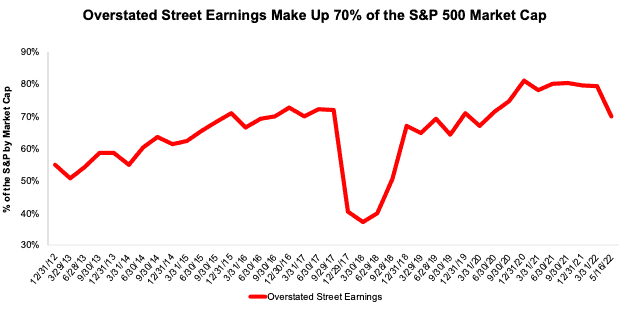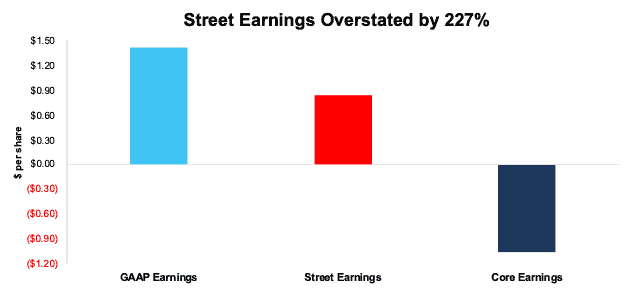GAAP Earnings exaggerated the drop in 2020 and overstated the rebound in S&P 500 earnings in 2021. In the trailing-twelve-months (TTM) ended 1Q22, GAAP earnings continue to overstate the growth in Core Earnings[1]. We see the same trends in Street Earnings, as reflected in Zacks Earnings, which are reported to be adjusted to remove non-recurring items. This report shows:
- the prevalence and magnitude of overstated Street Earnings in the S&P 500
- why Street Earnings (and GAAP earnings) are flawed and not adjusted as promised
- five S&P 500 companies with overstated Street Earnings and an Unattractive-or-worse Stock Rating
Over 180 S&P 500 Companies Overstate EPS by More than 10%
For 333 companies in the S&P 500, Street Earnings overstate Core Earnings[2] for the trailing-twelve-months (TTM) ended calendar 1Q22. In the TTMs ended 1Q21 and calendar 2021, 362 companies and 336 companies overstated their earnings, respectively.
When Street Earnings overstate Core Earnings, they do so by an average of 19% per company, per Figure 1. For over a third of S&P 500 companies, Street Earnings overstate Core Earnings by >10%.
Figure 1: Street Earnings Overstated by 19% on Average in TTM Through 1Q22[3]
Sources: New Constructs, LLC and company filings.
The 333 companies with overstated Street Earnings make up 70% of the market cap of the S&P 500 through 5/16/22, which is down from 79% through 2021, measured with TTM data in each quarter.
The drop from the prior TTM period is driven largely by Microsoft (MSFT) and NVIDIA Corporation’s (NVDA) Street Earnings falling from overstated through 2021 to understated through 1Q22. Combined, these two firms make up 7% of the S&P 500 market cap through 5/16/22.
Figure 2: Overstated Street Earnings as % of Market Cap: 2012 through 5/16/22
Sources: New Constructs, LLC and company filings.
The Five Worst Offenders in the S&P 500
Figure 3 shows five S&P 500 stocks with an Unattractive-or-worse Stock Rating and the most overstated Street Earnings (Street Distortion as a % of Street Earnings per share) over the TTM through 1Q22. “Street Distortion” equals the difference between Core Earnings per share and Street Earnings per share. Investors using Street Earnings miss the true profitability, or lack thereof, of these businesses.
Figure 3: S&P 500 Companies with Most Overstated Street Earnings: TTM Through 1Q22
Sources: New Constructs, LLC and company filings.
*Measured as Street Distortion as a percent of Street EPS
In the section below, we detail the hidden and reported unusual items that distort GAAP Earnings for Expedia Group (EXPE). All these unusual items are removed from Core Earnings.
Expedia Group’s (EXPE) TTM 1Q22 Street Earnings Overstated by $1.91/share
The difference between, or Street Distortion in, Expedia’s Street Earnings ($0.84/share) and Core Earnings (-$1.07/share) is $1.91/share, or 227% percent of Street Earnings.
Expedia’s GAAP Earnings overstate Core Earnings by $2.48/share, which indicates that Street Earnings capture some, but not all, of the unusual items that distort GAAP Earnings for Expedia.
Figure 4: Comparing Expedia’s GAAP, Street, and Core Earnings: TTM Through 1Q22
Sources: New Constructs, LLC and company filings.
Below, we detail the differences between Core Earnings and GAAP Earnings so readers can audit our research. We would be happy to reconcile our Core Earnings with Street Earnings but cannot because we do not have the details on how analysts calculate their Street Earnings.
Expedia’s Earnings Distortion Score is Miss and its Stock Rating is Unattractive. Expedia receives an Unattractive rating due to its low return on invested capital (ROIC) of 3% and an expensive valuation. Despite trading at $124/share EXPE has an economic book value (EBV), or no growth value, of well under $1/share.
Figure 5 details the differences between Expedia’s Core Earnings and GAAP Earnings.
Figure 5: Expedia’s GAAP Earnings to Core Earnings Reconciliation: TTM Through 1Q22
Sources: New Constructs, LLC and company filings.
More details:
Total Earnings Distortion of $2.48/share, which equals $378 million, is comprised of the following:
Reported Unusual Gains Pre-Tax, Net = $2.56/per share, which equals $391 million and is comprised of:
- $456 million in gains on sale of businesses in the TTM period based on
- $402 million gain in 4Q21
- $54 million gain in 3Q21
- $22 million in other income in the TTM period based on
- $1 million in 1Q22
- $14 million in 4Q21
- $6 million in 3Q21
- $1 million in 2Q21
- $13 million in gains on minority equity investments in the TTM period based on
- $21 million gain in 1Q22
- $7 million gain in 4Q21
- -$11 million loss in 3Q21
- -$4 million loss in 2Q21
- -$20 million in reported write downs in the TTM period based on
- -$14 million impairment of goodwill reported in the 2021 10-K
- -$6 million intangible and other long-term asset impairment reported in the 2021 10-K
- -$26 million restructuring and related reorganization changes in the TTM period based on
- -$1 million in 4Q21
- -$12 million in 3Q21
- -$13 million in 2Q21
- -$54 million in foreign exchange rate losses in the TTM period based on
- -$17 million in 1Q22
- -$6 million in 4Q21
- -$24 million in 3Q21
- -$7 million in 2Q21
Tax Distortion = -$0.09/per share, which equals -$13.2 million
Our research shows both Street and GAAP earnings fail to capture significant unusual items impacting Expedia’s true profits.
This article originally published on May 27, 2022.
Disclosure: David Trainer, Kyle Guske II, and Matt Shuler receive no compensation to write about any specific stock, style, or theme.
Follow us on Twitter, Facebook, LinkedIn, and StockTwits for real-time alerts on all our research.
[1] The Journal of Financial Economics features the superiority of our Core Earnings in Core Earnings: New Data & Evidence.
[2] Our Core Earnings research is based on the latest audited financial data, which is the calendar 1Q22 10-Q in most cases. Price data as of 5/16/22.
[3] Average overstated % is calculated as Street Distortion, which is the difference between Street Earnings and Core Earnings.





